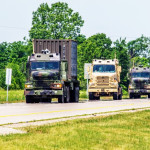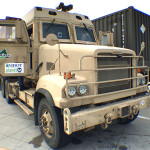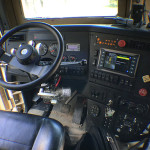
WHY THIS MATTERS IN BRIEF
US military convoys are often seen as soft targets in war zones around the world and that puts US service men and women at risk, autonomous trucks take more soldiers out of the firing line.
Late last month the US Army tested its latest driverless truck technology on Route 69 in Michigan as regular drivers looked on, oblivious to the fact that they were travelling next to the future of warfare. For all their humdrum khaki looks, these were platooning, semi-autonomous army trucks, moving as one, and since the successful test the Michigan based US Army Tank Automotive Research, Development and Engineering Center (TARDEC), who developed the trucks, have since suggested that Michigan could be ground zero in developing autonomous technology for commercial trucks. Although, that said, it might have to compete with Arizona for that privilege.
The four beta trucks involved in the experiment, equipped with cameras and LIDAR, were dropped into real Michigan traffic, with human drivers aboard as backups. They used dedicated short range radio, also known as Vehicle-to-Vehicle Communication (V2C) to communicate with each other and the smart infrastructure that Michigan’s DOT had installed specially for the experiment in order to get advance notice of things like changing speed limits and closed lanes ahead.
TARDEC is not the only company experimenting with autonomous trucks. Daimler, Peloton Technology and Otto, who recently completed their first fully autonomous commercial delivery, are working in this space too but the US Army’s involvement could make armed conflict a lot safer for soldiers.
The trucks drove as a convoy of one, also called a platoon – when the leader braked, the others braked, too and that instant responsiveness allowed them to travel so closely together, each drafted off the truck in front of it, enjoying the limited wind resistance, just like Tour de France cyclists.
Army engineers say that they believe fully autonomous truck convoys will be ready to serve in conflict zones in the next ten years, and the reasoning’s obvious.
“We want to get soldiers out of the convoy and away from IEDs,” says Alex Kade, who helps direct the Army center’s research in ground vehicle robotics, “robo-trucks could hump supplies around bases, or resupply soldiers at far flung outposts.”
Despite ethical questions around robotic and autonomous warfare though, a topic that will be debated by the UN this year, the US is pushing ahead all guns blazing – building and deploying everything from autonomous-capable destroyers and fully autonomous sub hunters, harbour patrol boats, drone squadrons and underwater drone highways.
But, for the trucks at least, there are challenges ahead. Like most other autonomous vehicles the technology will need to reliably spot a whole range of obstacles, but these trucks will need to be spot more than just road signs. They’ll need to be able to spot everything from rocks and craters in the road and suspicious objects to incoming fire then use advanced computation to make split second decisions, just like their human drivers. And they’ll have to navigate through areas with little or no communications infrastructure and where markings, signs, and pavements are out of date and poorly maintained.
It’s all a big challenge.



















